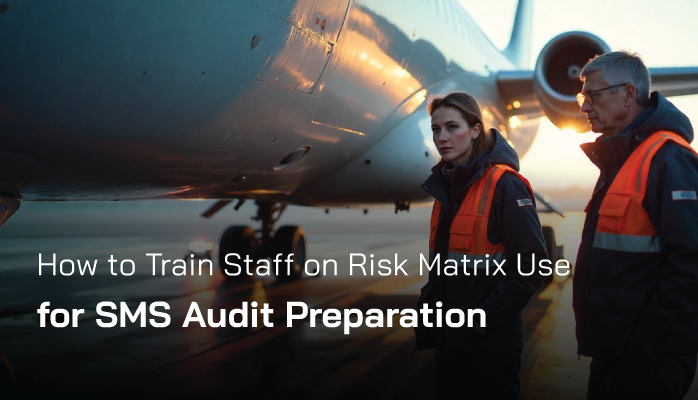What Is Risk Matrix?

For new aviation safety managers, preparing for a Safety Management System (SMS) audit can feel overwhelming. One of the most critical components of SMS compliance is ensuring that staff and accountable executives understand the risk matrix, its application in aviation safety risk management, and how it supports audit readiness. A well-trained team can confidently explain the risk matrix process, demonstrate compliance, and contribute to a culture of safety.
This comprehensive guide provides actionable steps to train your staff on the risk matrix’s use and process, ensuring your organization is audit-ready. Whether you’re new to SMS or refining your training approach, this evergreen article offers practical strategies to empower your team and streamline compliance.
Why the Risk Matrix Matters in Aviation SMS
The risk matrix is a cornerstone of aviation SMS, enabling organizations to assess, prioritize, and mitigate risks systematically. It categorizes risks based on their likelihood and severity, providing a visual tool to guide decision-making. For SMS audits, regulators like the FAA, EASA, or ICAO expect staff to demonstrate:
- Understanding: How the risk matrix is used to identify and evaluate hazards.
- Application: How it informs safety risk management decisions.
- Documentation: How risk assessments are recorded for compliance.
Training staff to articulate these concepts ensures your organization meets regulatory standards and fosters a proactive safety culture. Below, we outline a step-by-step approach to train your team effectively.
Step 1: Build a Foundation With SMS Concepts
Before diving into the risk matrix, ensure your staff understands the broader context of SMS. Many employees, especially those new to aviation safety, may lack familiarity with SMS principles. Start with a foundational training session that covers:
Key SMS Concepts
- Safety Policy: Explain how your organization’s safety policy aligns with regulatory requirements (e.g., ICAO Annex 19).
- Hazard Identification: Teach staff to recognize hazards in daily operations, such as runway incursions or maintenance errors.
- Risk Management: Introduce the risk management process, emphasizing the role of the risk matrix.
- Safety Assurance: Highlight how audits verify SMS effectiveness.
- Safety Promotion: Stress the importance of training and communication in fostering a safety culture.
Training Tip
Use real-world examples relevant to your operations (e.g., a near-miss incident at your airport) to make SMS concepts relatable. Interactive formats like workshops or case studies can boost engagement.
Related Aviation SMS Training Articles
- What Is Aviation Safety Training in Aviation SMS - Includes Videos to Use
- Why Employees Can’t Stand Aviation SMS Training
- 4 Pillars | 10 Things You Need to Know About Aviation Safety Training
Step 2: Demystify the Risk Matrix

The risk matrix can seem intimidating to staff unfamiliar with risk assessment. Simplify the concept by breaking it down into digestible components.
What Is a Risk Matrix?
A risk matrix is a grid that plots the likelihood of a hazard occurring against the severity of its consequences. Typically, it’s a 5x5 or 3x3 grid with color-coded risk levels (e.g., green for low risk, red for high risk). For example:
- Likelihood: Ranges from “Rare” to “Almost Certain.”
- Severity: Ranges from “Negligible” to “Catastrophic.”
- Risk Level: Combines likelihood and severity to categorize risks as Low, Medium, or High.
How to Explain It
Train staff to describe the risk matrix as a decision-making tool that helps prioritize safety actions. For instance, a “Rare” but “Catastrophic” hazard (e.g., engine failure) may require immediate mitigation, while a “Frequent” but “Negligible” issue (e.g., minor paperwork errors) may be monitored.
Training Activity
Create a mock risk matrix exercise. Provide scenarios (e.g., a bird strike risk during takeoff) and ask staff to plot them on a matrix. Discuss why certain risks are prioritized and how mitigation strategies are chosen.
Articles on Aviation SMS Risk Matrix
- What Is a Risk Matrix and Risk Assessment in Aviation SMS
- How to Define Severity and Likelihood Criteria on Your Risk Matrix
- How to Create Your Risk Matrix for Risk Assessments in Aviation SMS
Step 3: Teach the Risk Matrix Process
Once staff understand the risk matrix, train them on the process of using it within your SMS. This involves a structured approach to hazard identification, risk assessment, and mitigation.
The Risk Management Process
- Identify Hazards: Staff should report hazards through your SMS reporting system (e.g., a digital tool or paper form).
- Assess Risks: Use the risk matrix to evaluate the likelihood and severity of each hazard.
- Determine Risk Level: Assign a risk level (e.g., Low, Medium, High) based on the matrix.
- Develop Mitigation Strategies: Propose controls to reduce likelihood or severity (e.g., additional training, equipment upgrades).
- Document and Monitor: Record the assessment and track mitigation effectiveness.
Training Tip
Use flowcharts or diagrams to visualize the process. For example, create a step-by-step guide that staff can reference during training and on the job.
Compliance Focus
For audit preparation, emphasize documentation. Auditors will review risk assessments to ensure they are thorough, consistent, and aligned with your SMS manual. Train staff to:
- Complete risk assessment forms accurately.
- Link each assessment to specific hazards and mitigation plans.
- Store records in an accessible, audit-ready format.
Step 4: Engage Accountable Executives

Accountable executives (e.g., CEOs, directors, or operations managers) play a critical role in SMS. They must understand the risk matrix to support safety decisions and demonstrate leadership during audits. However, executives may lack technical knowledge or time for in-depth training.
Tailored Training for Executives
- Simplify the Message: Focus on the risk matrix’s role in prioritizing resources and ensuring compliance.
- Highlight Accountability: Explain that auditors will expect executives to articulate how they oversee SMS and use risk assessments to guide decisions.
- Use Strategic Examples: Show how risk matrix outcomes influence budgeting (e.g., investing in new safety equipment) or policy changes.
Training Activity
Conduct a short, high-level workshop for executives. Present a case study (e.g., a runway safety issue) and walk them through the risk matrix process, emphasizing their role in approving mitigation plans.
Related Articles on Accountable Executives in Aviation SMS
- 3 Scenarios for Accountable Executives to Minimize Risk to Aviation SMS
- How to Choose the Best Aviation SMS Software: A Guide for Safety Managers and Accountable Executives
- Executive Manager Role in Safety Management Systems
Step 5: Make Training Interactive and Ongoing
Effective training goes beyond one-off sessions. To ensure staff retain knowledge and stay audit-ready, incorporate interactive and continuous learning.
Interactive Training Methods
- Role-Playing: Simulate an audit scenario where staff explain the risk matrix to a “regulator.”
- Quizzes: Use online quizzes to test understanding of risk matrix concepts and processes.
- Group Discussions: Encourage staff to share real-world examples of hazards they’ve encountered and how they’d assess them.
Continuous Learning
- Refresher Courses: Schedule quarterly or annual SMS training to reinforce risk matrix skills.
- Safety Bulletins: Share updates on SMS best practices or lessons learned from recent audits.
- Feedback Loops: Encourage staff to provide input on training effectiveness and suggest improvements.
Step 6: Prepare for the Audit

Audit preparation requires staff to confidently explain the risk matrix and demonstrate compliance. Here’s how to ready your team:
Mock Audits
Conduct practice audits to simulate regulator questions, such as:
- “How do you assess the risk of a reported hazard?”
- “Can you show me a documented risk assessment?”
- “How does the risk matrix guide your safety decisions?”
Assign staff roles (e.g., frontline employee, supervisor, executive) and provide feedback on their responses.
Common Audit Pitfalls
Train staff to avoid these issues:
- Vague Explanations: Ensure staff can clearly describe the risk matrix’s purpose and process.
- Incomplete Documentation: Verify that all risk assessments are fully documented and accessible.
- Lack of Executive Buy-In: Confirm that executives are prepared to demonstrate leadership in SMS.
Training Tip
Create a “cheat sheet” summarizing the risk matrix process and key audit questions. Distribute it to staff as a quick reference.
Related Aviation SMS Audit Articles
- How Often Should You Conduct Aviation SMS Audit
- 9 Best Strategies for Aviation Safety Audit Preparation [Free Audit Checklists]
- Aviation Safety Audit Preparation - 4 Free SMS Audit Templates
Step 7: Foster a Safety Culture
Training on the risk matrix isn’t just about compliance—it’s about embedding safety into your organization’s DNA. Encourage staff to view the risk matrix as a tool for proactive risk management, not just an audit requirement.
Strategies to Build a Safety Culture
- Recognize Reporting: Reward staff who identify and report hazards.
- Communicate Successes: Share examples of how risk matrix assessments prevented incidents.
- Empower Staff: Encourage all employees, from ground crew to executives, to take ownership of safety.
Training Activity
Host a “Safety Day” where staff present risk matrix case studies and discuss their impact on operations. This reinforces the tool’s value and builds team cohesion.
Tools and Resources for Training
To streamline your training efforts, leverage these resources:
- SMS Software: Tools like SMS Pro's Aviation Safety Management Software or ABC can digitize risk assessments and provide training modules.
- Regulatory Guides: Reference FAA AC 120-92B, EASA SMS guidelines, or ICAO Doc 9859 for compliance standards.
- Training Platforms: Use e-learning platforms like Coursera or LinkedIn Learning for supplemental SMS courses. SMS Pro includes a built-in LMS within its Training and Qualifications module.
Conclusion
Training staff to explain the risk matrix’s use and process is a critical step in preparing for SMS audits. By building a strong foundation in SMS concepts, demystifying the risk matrix, and engaging both staff and executives, new safety managers can foster compliance and a robust safety culture. Interactive, ongoing training ensures your team is audit-ready and confident in their roles.
Start small with foundational sessions, scale up with practical exercises, and maintain momentum with continuous learning. With these strategies, your organization will not only pass SMS audits but also elevate its commitment to aviation safety.
Ready to enhance your SMS training? Share this guide with your team and explore tools like SMS software to streamline your audit preparation.








